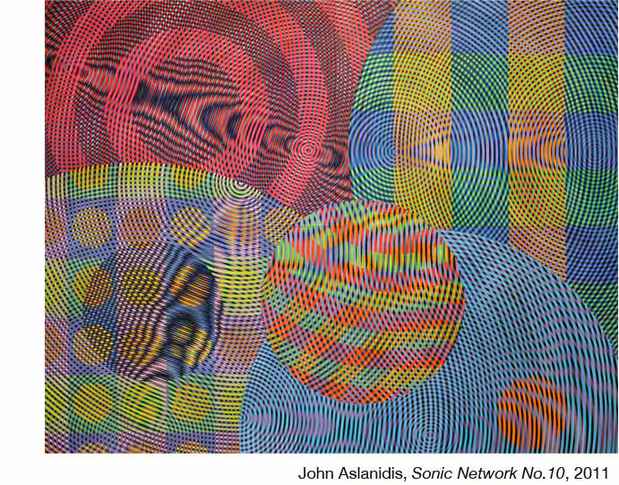"Sounds Good" Exhibition
Location One

This event has ended.
Location One presents Sounds Good, featuring visual responses to a collaborative sound piece by artists John Aslanidis, Katy Dove, Phoebe Hui, Sophie Hunter, Miler Lagos, John O’Connell, Gonzalo Puch, and Zane Saunders. The pieces relate to movement, rhythm, vibration, energy, and the expanding visual field.
Australian artist John Aslanidis’s monumental painting Sonic Network no.10 comprises four canvases that translate the vibrations of sound into a visual display. At first, the composition of colorful squares seems optically chaotic. This apparent chaos, however, is the result of a meticulously orchestrated, laborious process that recalls the madness of order. From far away his canvases look as if they are randomly composed, but as the viewer approaches it becomes clear that they are actually highly organized abstract geometric grids, with chance elements interspersed to interrupt the rigidity of his web.
Katy Dove’s work for this exhibition responds to the rhythm and movement that has been involved in developing the collaborative sound track through group improvised music sessions. Repetitive mark making, the action of ink slowly drying, and the geometry that comes from movement of the hand echo the human and textural qualities of the sound. The resulting works on fabric and in moving image suggest a psychological state inherent in these processes. Based in Glasgow, Scotland, Dove is known for animations that juxtapose bodily motions with abstract shapes, mixing the organic and the geometric.
Hong Kong–based artist Phoebe Hui took inspiration from a harmonograph—a musical instrument made of two pendulums suspended through holes in a table—for her interactive audiovisual installation Granular Graph II: The Tank and the Pendulum. In this work, Hui invites the viewer to become a living pendulum, swinging on the instrument’s ropes and giving rise to a mix of vibrational patterns and sounds. Hui’s experimentations with music and kinetics also led her to create Vexation – for K, an electronic musical instrument that plays the composition “Vexation” by French composer Erik Satie. The audience can play the instrument by rotating a compass, thus creating a variety of tones through the contact of different shades of pencil marks on the soundboard.
British theatre director Sophie Hunter’s installation Lucretia is based on a fragment of Benjamin Britten's opera The Rape of Lucretia—specifically, the image of a group of women spinning at a loom as their husbands are off waging war. Hunter extracts various elements of the opera, such as the orchestra, the narrative, and the opera house itself, and deconstructs and examines them devoid of their original context. She then reassembles these elements to record an altogether new score—a densely collaged soundtrack made of both music and noise—drawing a parallel between the act of weaving and the recording or encoding of information and memory.
Colombian artist Miler Lagos reflects on the relationship between the natural and the artificial worlds. His five-minute video Attraction shows a heart-shaped red balloon plunging into the water. The impact of the fall is dramatically amplified, creating the effect of an exaggerated explosion. To create his sculpture Cimiento, Lagos began with a stack of seven thousand sheets of paper, each printed with an image of a woodcut by the Japanese artist Ottawa Hiroshige, and painstakingly carved it into the shape of a log. In Tree Rings Dating, four hundred identical pages from The New York Times come together in a mesmerizing three-dimensional collage—a spherical form with a transversal cut simulating the rings of a tree. The sculpture alludes both to the recording of the passage of time and to daily events, since it is made out of newspapers.
John O’Connell, a multimedia artist from Dublin, Ireland, is represented in the exhibition by a series of drawings evoking an intimate and dreamy environment. Built from a myriad of interrelated elements borrowed from his make-believe universe, the drawings straddle the line between real and fictional, process-based and result-oriented. To create these fantastical compositions, O’Connell begins with hand-constructed miniature set models that reproduce the imaginary landscapes of the artist’s poetic, whimsical, and lyrical universe.
Spanish artist Gonzalo Puch’s wall curtain juxtaposes disparate elements in unexpected and often funny tableaux, suggesting intricate narratives out of random elements. Plants, flowers, and pieces of food inhabit his curtain with photographs, sketches, and drawings, creating an open environment populated by the artist’s imagination. It is a world where chaos is not a threat, but a generative force inviting viewers to think outside of their comfort zone. Though Puch is interested in a variety of issues, including science, music, biology, and environmental studies, his art draws primarily on nature for both themes and materials.
Zane Saunders’s series of ceramic-fired clay wall sculptures are inspired by organic forms. His designs utilize a variety of waving shapes that recur in natural landscapes. Saunders was born in Cairns, North Queensland, Australia, where he still works today. He explores issues related to spirituality and the environment, often juxtaposing elements from nature and contemporary life. Through his use of raw and organic materials, he conveys a sense of the beauty and wonder lurking in the world all around us.
Media
Schedule
from June 14, 2011 to July 29, 2011
Opening Reception on 2011-06-14 from 18:00 to 20:00